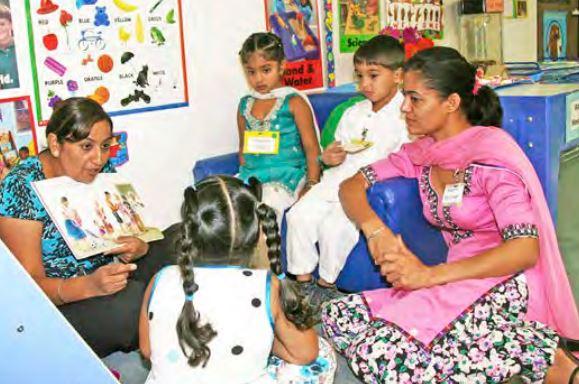27 5.6: Suggestions for Your Program and Classrooms
Suggestions for Your Program and Classrooms
1. Respect the Uniqueness of Each Family System
Characteristics of the family system are often heavily influenced by a family’s cultural values and beliefs. For example, researchers have found that, in some cultures, the family unit includes extended family members or clans composed of several households of relatives with a commitment to a family-based support network, while other families tend to focus on the immediate family and utilize external support networks. Knowledge and understanding of the variety of family structures and systems increase the professional’s ability to respond to the family’s needs. In turn, respect for the diverse systems of family organization enhances a professional’s effectiveness.
2. Develop a Personalized Relationship with Families
Families are more likely to develop effective working relationships with professionals they trust. Yet, this relationship may be forged in different ways. Some families may prefer a more formal relationship with early education professionals, while others may prefer a more informal, friendly relationship. In some cultures, the father may be considered the head of the household and, therefore, may be responsible for making decisions for the rest of the family. In other cultures, the oldest female member of the household may hold the position of authority. Researchers in the early education field suggest that these issues need to be considered on a family-by-family basis, because intra-group differences are as great as inter-group differences. Awareness of these differences increases the likelihood of building effective relationships.

3. Communicate in Culturally Appropriate Ways
Cross-cultural differences in communication may also affect professional
-family relationships. For example, researchers note that if professionals assume a dominant role in conversations, the submissive role in which the family is placed may be a source of tension and may result in family members withholding information. Communication of this type may be particularly offensive to some families from traditional Hispanic, Native American, and Asian backgrounds. As discussed in the literature, knowledge of issues related to the use of translators and interpreters is important for early education professionals because communicating with linguistically diverse families often requires individuals fluent in the family’s primary language to explain or clarify information related to programs and services.
It is also critical to maintain open, ongoing communication with families from diverse linguistic backgrounds. This communication may take the form of home-program notebooks, oral exchanges, or other modes of communication based on each family’s preferences.
4. Recruit Staff Who View Diversity as an Asset
Efforts should be made to hire bicultural and bilingual staff to increase an organization’s ability to create trust between families and professionals. However, researchers note that what is even more essential is to hire staff who embrace diversity as an asset and demonstrate a willingness to learn about the experiences and traditions of individuals whose backgrounds are different from their own. By recruiting such individuals, early childhood programs will substantially enhance their ability to work with families from diverse cultural backgrounds.
5. Create Alliances with Cultural Guides
It is important to encourage the participation of community leaders as “cultural guides” to facilitate communication and understanding between professionals and families. The literature describes several roles these individuals can play:
- Provide professionals with insights concerning community beliefs, values,
and communication style. - Offer families information about programs and services in a culturally sensitive and responsive manner.
- Act as facilitators to bring families and professionals closer together to reach desired outcomes.
Examples of cultural guides include community leaders, members of the clergy, and business leaders who are from the family’s cultural group or who speak the family’s primary language.
6. Evaluate Process and Outcomes
The final strategy addresses the need for ongoing evaluation of early childhood programs that serve diverse families. Evaluation can take several forms, such as asking families to complete surveys or sharing information through face-to-face or phone interviews. Early education professionals may also participate in program improvement activities by conducting a needs assessment to identify areas for training and then self-evaluating their knowledge and skills in those areas. With collaboration from bicultural/bilingual staff and cultural guides, information can be collected in ways that match families’ preferences. In turn, early education professionals can use this information to improve their programs and their interactions with families. [63]
|
What about Holidays? |
|
Talking and thinking about holidays in early childhood programs today is a “hot topic.” Diversity among children, families, and staff who make up our programs is ever increasing. Many of us believe that holidays should be celebrated, while many others think celebrations do not belong in the classroom. These opposing views have created a divide and uncertainty on whether to celebrate. As an industry, (and even program by program) we need to discuss the decision and ramifications on whether ‘to celebrate or not to celebrate’. [64] The Southern Poverty Law Center notes on their Teaching Tolerance website that there are some things programs should avoid doing when it comes to celebrating:
And the National Association for the Education of Young Children reminds us to remember that
Programs that choose to celebrate holidays should take care to make sure that what is celebrated represents all of the children and families their program serves. This requires meaningful conversations between staff and families. This should be done through respectful dialogue and requires staff to keep an open-mind about things beyond their personal experiences and beliefs and to trying new things and new ways of celebrating. [67] |
|
|
Think About It… One holiday that has evoked concerns about bias and equity is Thanksgiving. What are concerns that people have about Thanksgiving? How might a program navigate those concerns? How does this play a part in ensuring there is equity in what is celebrated and how it is celebrated? |


